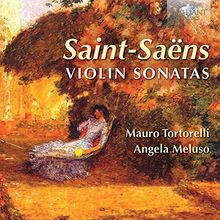
1 Violin Sonata No. 1 in D Minor, Op. 75: I. Allegro agitato -
2 Violin Sonata No. 1 in D Minor, Op. 75: II. Adagio
3 Violin Sonata No. 1 in D Minor, Op. 75: III. Allegretto moderato -
4 Violin Sonata No. 1 in D Minor, Op. 75: IV. Allegro molto
5 Berceuse in B-Flat, Op. 38
6 Violin Sonata No. 2 in E-Flat, Op. 102: I. Poco allegro piu tosto moderato
7 Violin Sonata No. 2 in E-Flat, Op. 102: II. Scherzo: Vivace
8 Violin Sonata No. 2 in E-Flat, Op. 102: III. Andante
9 Violin Sonata No. 2 in E-Flat, Op. 102: IV. Allegro grazioso, non presto
10 Triptyque, Op. 136: I. Prémice
11 Triptyque, Op. 136: II. Vision congolaise
12 Triptyque, Op. 136: III. Joyeuseté
Although sometimes disregarded as a conservative composer, looking back at a time when other composers were looking to the future, Saint-Saëns's output towards the end of his life actually remained highly original. His music for violin and piano is no exception. An experienced traveller, Saint-Saëns was inspired by his voyages in East Asia, particularly China, and these exotic elements come to the fore in Triptyque Op.136, the 'almost sonata', which was the last of the composer's major works for violin and piano. The three sections, Prémice, Vision congolaise and Joyeuseté, are a tribute to the composer's fascination with the East, a popular topic in France at the time. The earlier works, the two violin sonatas and Berceuse, or 'lullaby', are also less indicative of Saint-Saëns's conservatism than many would believe. Indeed, the listener is treated to a variety of innovations, such as frequent cross-accents in the second sonata and the rapid changes of metre that appear in various phrases in the first sonata. It is true, though, that Saint-Saëns refused to allow his output to be engulfed by the Wagnerian tradition gathering pace in Germany, and this means that his music remains characteristically and unabashedly French.